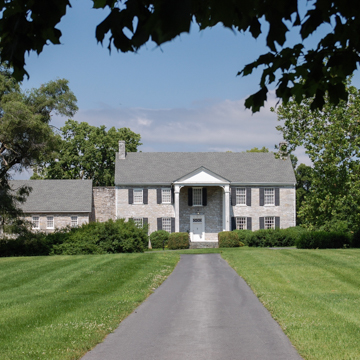The Kenilworth property was part of a 1,332-acre tract granted to Quaker settler John Littler in 1735. Considerably later, the main block of this large limestone dwelling was constructed in two different sections. Named Rockland, the original c. 1800 southern portion of the house with a side-passage plan was constructed by one of Littler's grandsons. After William Stephenson acquired the property, he changed its name to Kenilworth and extended the house by two bays, creating a center-passage plan. The gangly portico was added in the early twentieth century. Until the 1920s, the property remained in the possession of the Stephenson family for whom the community of Stephenson is named. The property's history took an unconventional turn when Harry K. Thaw purchased it in 1924. Thaw, who murdered nationally known New York City architect Stanford White, escaped conviction with a plea of insanity. Joining several civic organizations, Thaw quickly became a colorful and eccentric figure in the community and wore the red uniform of a Winchester fire company in many local parades.
You are here
Kenilworth
If SAH Archipedia has been useful to you, please consider supporting it.
SAH Archipedia tells the story of the United States through its buildings, landscapes, and cities. This freely available resource empowers the public with authoritative knowledge that deepens their understanding and appreciation of the built environment. But the Society of Architectural Historians, which created SAH Archipedia with University of Virginia Press, needs your support to maintain the high-caliber research, writing, photography, cartography, editing, design, and programming that make SAH Archipedia a trusted online resource available to all who value the history of place, heritage tourism, and learning.

